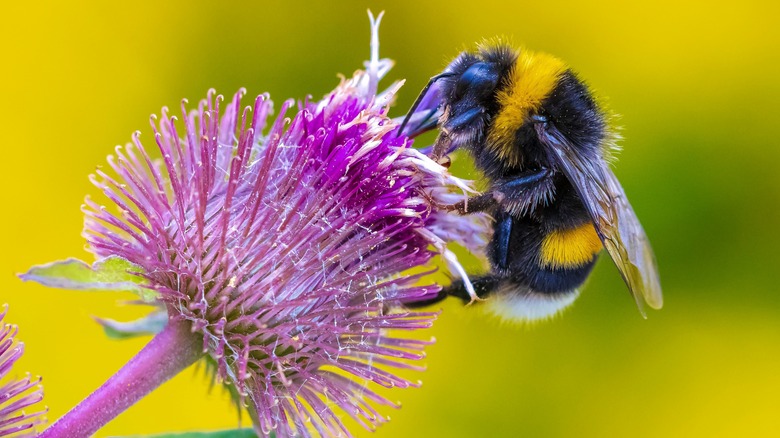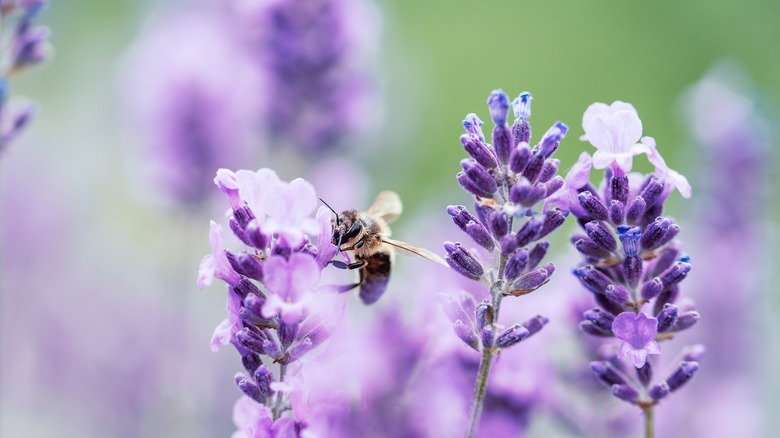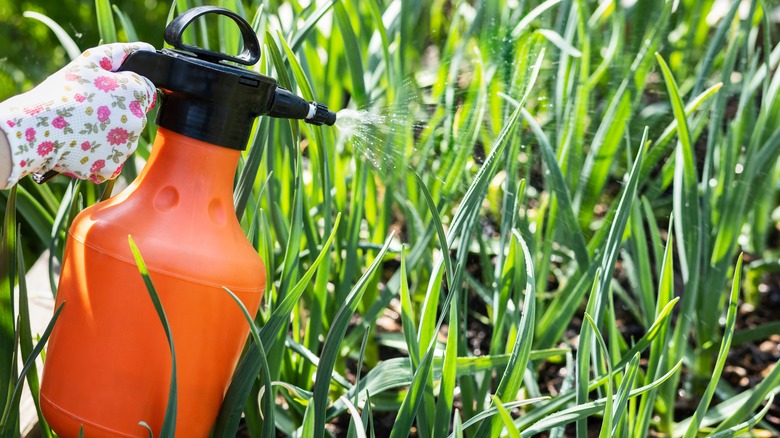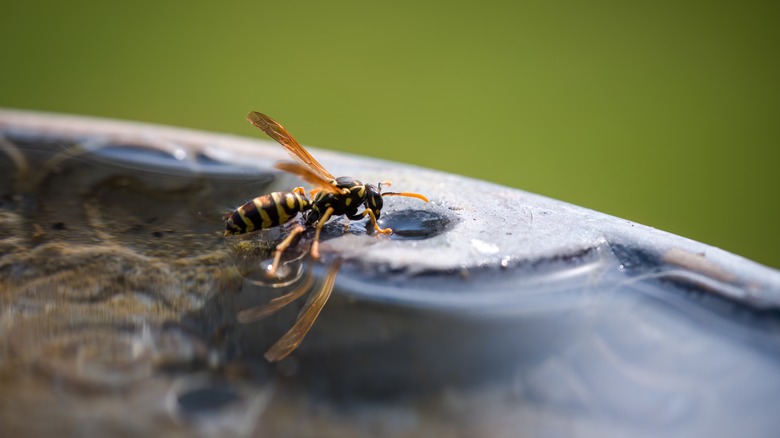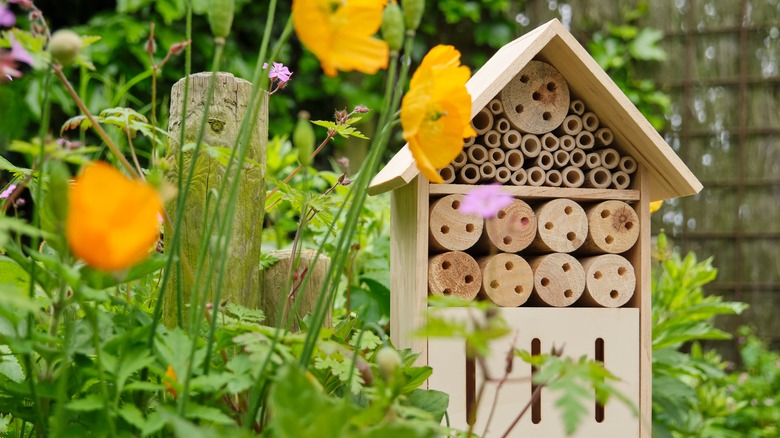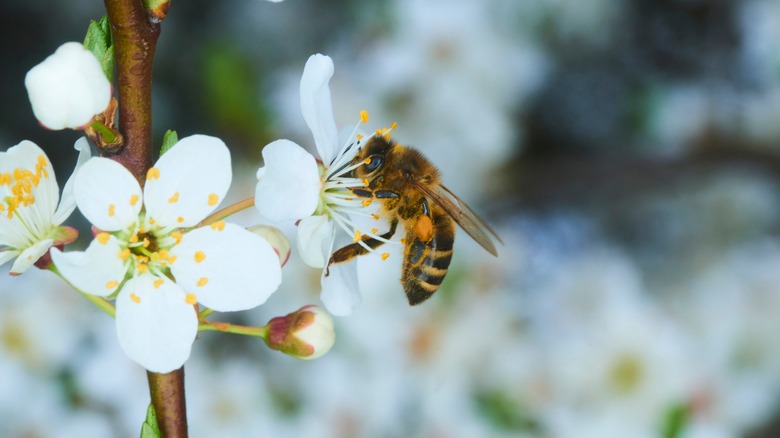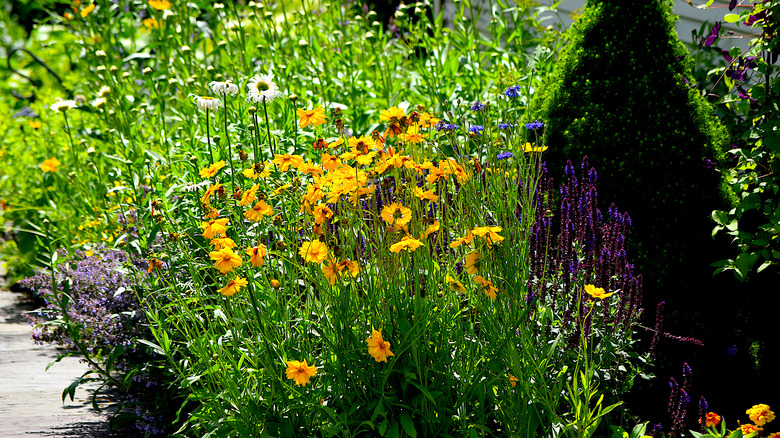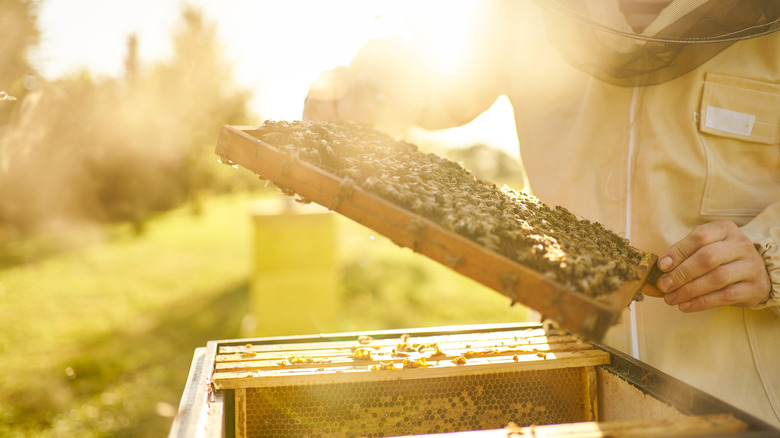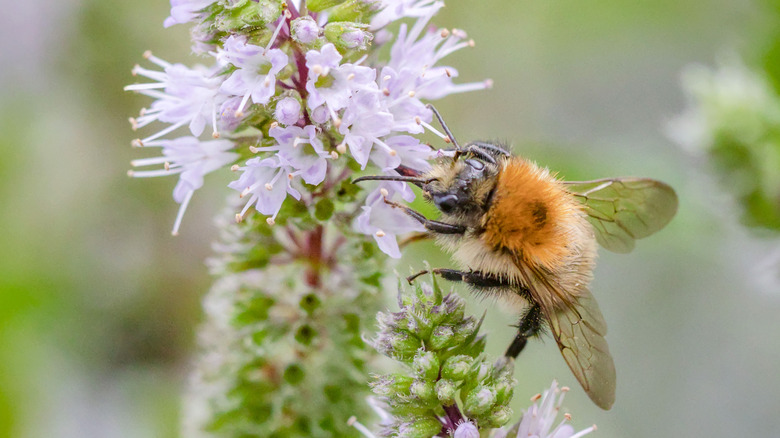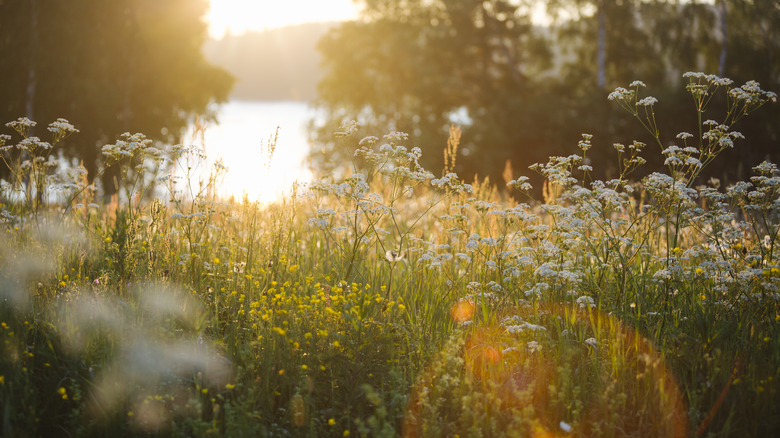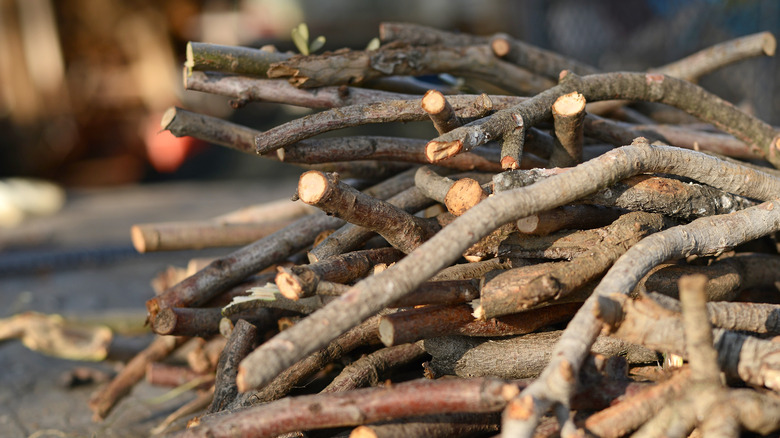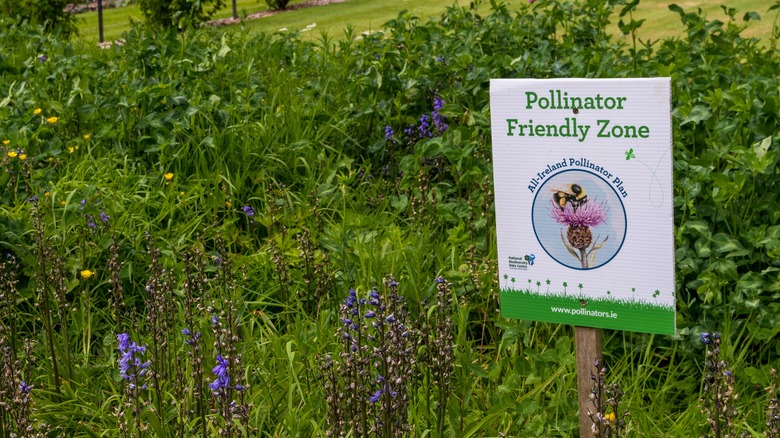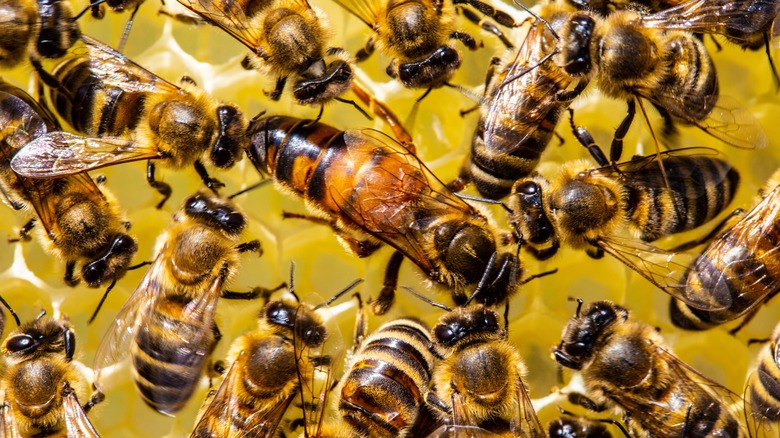12 Tips To Make All The Bees Come Buzzing To Your Garden
There is little doubt that bees are beneficial to your garden, and you should think twice before killing these insects. Not only do they serve a vital function for plant health, but they are able to foster the overall ecological welbeing of the entire garden. Plus, they also make honey. Therefore, you, as the gardener, ought to be doing everything possible to encourage bees' presence. The more bees you can bring into your lawn and garden, the healthier it will be.
The primary function of bees is to aid in the necessary act of pollination. When a bee draws nectar from a flower, it also collects that flower's pollen on its fuzzy legs and abdomen. It then carries that pollen to other flowers it lands on, which helps the plant produce fruits and seeds. Pollination is necessary for plant survival, and the bees are an important part of that process. Overall, garden health improves when pollinators carry pollen to plants that desperately need it.
So, while you want to do everything you possibly can to encourage the right kinds of bees to come into your yard, you might not quite know how to do it. This list gives you tips on how you can get these busy little workers buzzing into your yard and get them to stick around long term.
Devote a corner to pollinator-friendly flowers
The easiest thing you can do to attract bees is to plant the types of flowers from which they love to draw nectar. You can do this anywhere in your garden. You can sow flowers in your orchard and vegetable patch or even dedicate a whole corner of your yard to pollinator-friendly flowers. It doesn't matter how many you plant. If you plant the right ones, bees will be buzzing in your yard in no time.
There are two different ways you could go about this. The first is to design your pollinator garden with the types of flowers both you and the bees love. Think colorful and fragrant flowers like bee balm, marigolds, lupines, lavender, coneflower, ornamental allium, goldenrod, and black-eyed Susans. Planting one or a combination of these flowers is bound to attract bees to your yard.
The other method is to plant with reckless abandon in a sunny section of your yard. We'll discuss this in detail later, but this type of planting is a great approach for anyone with unused space in their yard. Try planting meadow flowers like clover, daisies, and ox-eyes. As long as there is something to whet their appetites, you will get bees in your yard.
Avoid chemical pesticides
The purpose of chemical pesticides is to create an environment within your garden where pestilential insects cannot hope to survive. These chemicals are often harsh and do their job effectively by taking care of the bad insects by targeting their nervous system. Unfortunately, like how antibiotics work in the human body, pesticides don't discriminate when it comes to the types of insects they eliminate. Pesticides kill both harmful and beneficial insects, which is bad news for the bees you're hoping to attract.
Bees are especially susceptible to pesticides. Since many chemical pesticides are used to help get rid of harmful wasps, flies, ticks, and worms, any chemical concoction will also affect native pollinator populations. Trust us, it's not worth decimating an entire honeybee population just to keep caterpillars away from your tomatoes.
Then, there is the fact that pesticides are also harmful to human health. If they are designed to target an insect's nervous system, imagine what they can do to you. Therefore, instead of going the chemical route, opt for all-natural pesticides like garlic or cinnamon (known for working wonders for your garden) to keep pests away. They do the job just as effectively without causing adverse harm to your bees or yourself.
Create a water source
Like people, bees need water to survive. Their needs are not quite as intense as ours, but water is still a necessity. When a bee is properly hydrated, it works harder out of the hive and produces more honey. Another benefit is that by bringing water to the hive, the bees will help regulate the hive's internal temperature and keep things from getting too hot during the heat of summer.
It's not difficult to create a water source for bees. If you have the money and time, investing in a small coy pond or an ornamental fountain is a great way to bring water to your local bee population. However, it is far easier to buy one or two affordable bird baths and keep them full of water. The reason to buy more than one is so that birds won't be picking off too many of your bee friends.
You can set up these bird baths across your garden to attract the bees to the various sections. Having a water source for the bees will help them stay hydrated, while also ensuring that they keep come to your garden to do their pollination thing as well.
Build a beehouse
Bees build their own homes. However, just like people, if a bee can move into a home that is already built and furnished, it will do so. Building a bee house is a great garden DIY project that will have the pollinators come buzzing into your yard. There are numerous different designs you could go with, but the main function of the house has to be as a place where the bees will be sheltered from predators and the elements.
This is easiest done with small pieces of wood. Popsicle sticks, twigs, small tree branches, and even hollowed-out reeds are great, easy-to-find materials that will serve as the foundation for your DIY bee house. The only thing you need to make sure of in the design is that the entry points are large enough for the bees to enter, but not so large for something like a bird or large wasp to get in.
Some of the most beneficial types of bees will respond very well to you building them a home. Mason bees and blue orchard bees are among the best pollinator varieties you could hope to attract. They are hard workers, and their quiet, calm demeanors make for a great presence in gardens and orchards.
Plant fruit trees
Though planting fruit trees is a must for anyone hoping to attract pollinators to their yard, it's also a way to setup a consistent food source for decades. There is nothing a buzzing bee loves more than to spend an entire day hovering around your flowering fruit tree, bringing pollen and nectar back to the hive, sustaining the colony with great abundance, and helping your fruit tree in the process. The great thing about establishing an orchard is that it can be done successfully almost anywhere in the United States.
You will need to do some research as to what fruit trees will work best in your area, but you certainly won't have a shortage to choose from. Bees love all fruit trees. Apples, peaches, plums, pears, and cherries all create the ideal environment for pollinators to thrive. Even after the fruit has grown and dropped to the ground, the bees will be able to extract sugars from the fruit. It's a fantastically regenerative cycle.
Note, however, that when you first plant a fruit tree, you cannot expect it to begin producing any fruit for at least a few years. So, it would behoove you to build that DIY bee shelter in your fledgling orchard to encourage bees to come to the area and begin adding their pollinating benefits to your garden before the trees are even flowering.
Companion plants make great bee attractors
You should have been in the habit of planting companion plants in your garden long before you thought about growing ones that specifically attract pollinators. Companion plants do an excellent job of aiding in the health of flowers like roses, repelling pests, and driving pollinators like bees to your garden. As such, you will want to do some research as to what companion plants will work best for the plants you already have in your garden and the types of pollinators they will bring to your yard.
For bees, there are a couple of companion plants that send them buzzing (literally!). Bee balm, marigolds, ornamental allium, flowering tobacco, and foxgloves are some of a bee's favorite companion plants. They offer an excellent amount of nectar and pollen for them to feast on, thereby providing bees the energy they need to keep being buzzy (get it?) in your yard.
The excellent thing about most companion plants is that they are hardy perennials. This means that you can plant them once and be good for a long time to come. They will continue to return and flower every spring, alerting the bees that it is time to get to work and pollinate the garden.
Have you considered beekeeping?
It is all well and good to build bee shelters and plant the types of things that bees love to feast on, but have you considered potentially purchasing bees and bringing them to your property? Beekeeping is a centuries-old practice that has numerous personal and environmental benefits. Not only does it physically plant these fantastic pollinators in your garden, but you also get an incredible byproduct as a result of all the bees' hard work: honey!
That's right; these bees will fly around your yard and bring health to numerous different plants. Additionally, the nectar they bring back to the hive and the honey they produce has so many different health benefits. Not only is honey an excellent and healthy alternative to processed sugars in your baking, but some say it has even lessened their seasonal allergies owing to the pollen content present.
You can purchase all the equipment you need for successful beekeeping, such as the bees themselves, hives, protective suits, and honey processing equipment, either online or at a specialist store. You could also build the hives yourself if you're particularly handy. It also wouldn't hurt to take some beekeeping classes before purchasing your first hive.
Native plants create bee-friendly ecosystems
Hybrid plants, while exceptionally beautiful, do present some problems when it comes to attracting pollinators. You see, in many cases, hybrid plants are not the result of natural cross-pollination. They are often bred specifically to remove any scent or nectar. In doing this, the hybrid maintains its unique genetic identity, but it yields no benefits to pollinators in the process. In fact, pollination of these plants has to be strictly controlled to keep the variety true. This is why any gardener looking to attract more bees to their yard would do well to plant native varieties.
Native plants are those that grow naturally in your area. This differs for every state and region in the country, so you will need to do your research on the native plants in your specific area. The great thing about them being native is that you know they will grow without too much input on your end. It's almost a stress-free guarantee of attracting bees to your yard.
If you're unsure as to what you can cultivate, there are numerous field guides you could use for research, or better yet, visit your local Extension Office. They offer excellent knowledge about what plants grow natively in your area, as well as which ones will complement your space and create a cohesive ecosystem.
Don't stress over weeds
There is a trend in gardening called lazy gardening, and pollinators are all here for it. While you should never let your garden become so overrun with weeds that you cannot access your plants, leaving your yard and garden alone for a few weeks is actually going to help its overall health. Here's how.
There are certain grasses and weeds, such as clover and milkweed, that are actually amazingly attractive to pollinators. Unfortunately, weekly mowing and weeding often take these out of our yards in favor of perfect manicuring. The concept of the two-week lawn is one where the lawn is allowed to grow a little taller and allow the pollinators time to come and do their business.
Now, if you absolutely cannot stand the site of a weedy garden or lawn, consider planting a wilding field or meadow. If you have the space, dedicate a section of your yard solely to being overgrown. This will attract a bunch of pollinators while also allowing you to stay focused on your gardening and weeding. Plus, if you sow this small meadow with enough pollinator-friendly weeds and grasses, the rest of your yard and garden will thank you for it.
Leave some branches in a pile for a natural bee shelter
While a large pile of branches right in your garden is not going to be remotely slight, there is good reason not to get rid of them entirely. A good pile of branches somewhere off to the side of your garden is actually going to attract those very bees that you want to be pollinating your plants. So, find an out-of-the-way spot nearby and build up a small brush pile. Before you know it, you will be attracting bees.
How exactly does a brush pile attract bees? Well, it is kind of like a symbiotic relationship. The branches make for an excellent shelter for chipmunks, squirrels, and small birds. They will burrow through the branches and form their nests deep within the pile. All that brush being pushed out of the way will provide the softened space necessary for the bees to take hold.
While wasps and hornets do love a good brush pile, so too do the likes of mason and bumblebees, both of which are very friendly and provide excellent pollinator services to your garden. One or two small brush piles will go farther than you think to encourage pollination in your garden.
Consider getting your garden certified
Now, a bee is not going to know whether or not your garden is certified pollinator friendly. However, there is good reason not to write this off as just a silly gimmick. When you go through the process of getting your garden certified for pollinators, you will learn how to create an environment where bees will thrive.
States like New Hampshire and Maine offer programs that can help you get your garden certified pollinator friendly. The joint endeavor between the University of Maine and the University of New Hampshire extension offices is a 4-step guide to help you provide food and water for the pollinators, have adequate shelter for them, and take the necessary steps to ensure that your property will remain pollinator friendly for the long haul. This includes removing pesticides and invasive plants that don't aid in the overall health of your garden.
So, you can see that there is a lot on this list that we've already recommended that you do, but programs like the ones from U. Maine and UNH provide a step-by-step process for gardeners to create and foster the types of environments that bees will absolutely thrive in. So, while the bee doesn't care about the actual certification, the process you go through to get yours is only going to aid them in the long run.
Know thy bee
Finally, when it comes to bees, you want to make sure that you are doing what you can to attract the right kind to your garden. There are certainly some dangerous bees that you don't want anything to do with, but there are definitely others you want to read up on and know by sight so that you're not trying to get rid of them when you see them in your garden.
The types of bees you want to attract to your garden, as we've stated throughout, are those that will do their best to pollinate your plants without being a nuisance. These include the likes of mason bees, bumblebees, squash bees, blueberry bees, and European honey bees. All will do their part to help you develop a thriving and healthy garden.
Every single one of these tips is going to work to bring bees buzzing into your yard. The good news is that, even if you are allergic, the right bees will not come after you if you simply leave them alone and give them plenty of plants to pollinate. These little buzzers can really be a great help to the success of your garden!
